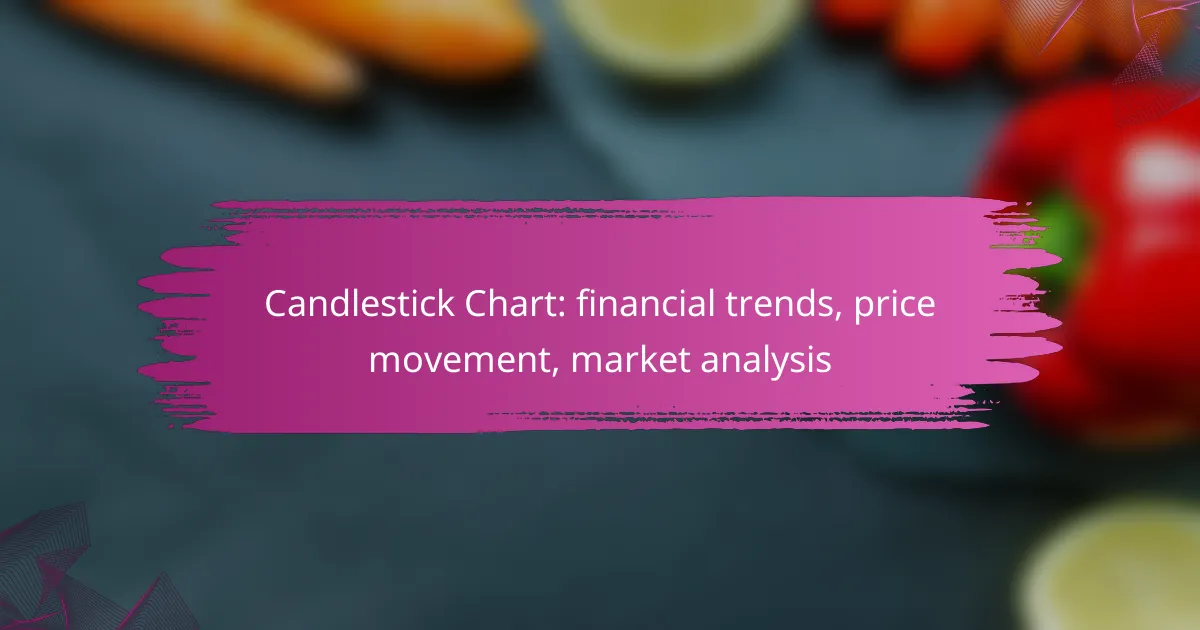Candlestick charts are essential tools for analyzing financial trends, providing a visual representation of price movements over specific time frames. By highlighting key price points—open, high, low, and close—these charts enable traders to interpret market sentiment and make informed decisions based on observed patterns and trends.

How to analyze financial trends using candlestick charts?
Candlestick charts are a powerful tool for analyzing financial trends, as they visually represent price movements over specific time frames. By examining the patterns formed by candlesticks, traders can gain insights into market sentiment and potential future price actions.
Identify price movements
To identify price movements using candlestick charts, focus on the open, high, low, and close prices represented by each candlestick. A single candlestick can indicate a price increase or decrease, while a series of candlesticks can reveal trends over time.
Look for patterns such as long-bodied candles, which suggest strong buying or selling pressure, and short-bodied candles, indicating indecision. Recognizing these movements can help traders make informed decisions about entering or exiting positions.
Interpret bullish and bearish patterns
Bullish patterns, such as the hammer or engulfing pattern, signal potential upward price movement, while bearish patterns like the shooting star or dark cloud cover indicate possible declines. Understanding these patterns is crucial for predicting market reversals or continuations.
For example, a bullish engulfing pattern occurs when a small bearish candle is followed by a larger bullish candle, suggesting that buyers have taken control. Conversely, a bearish engulfing pattern can indicate that sellers are gaining strength, prompting traders to consider short positions.
Utilize volume indicators
Volume indicators complement candlestick analysis by providing insight into the strength of price movements. High trading volume accompanying a price increase can confirm a bullish trend, while high volume during a price decline may validate bearish sentiment.
Traders should look for volume spikes that coincide with significant candlestick patterns, as these can indicate stronger market conviction. For instance, a breakout above resistance with high volume is often more reliable than one with low volume, suggesting that the trend is likely to continue.
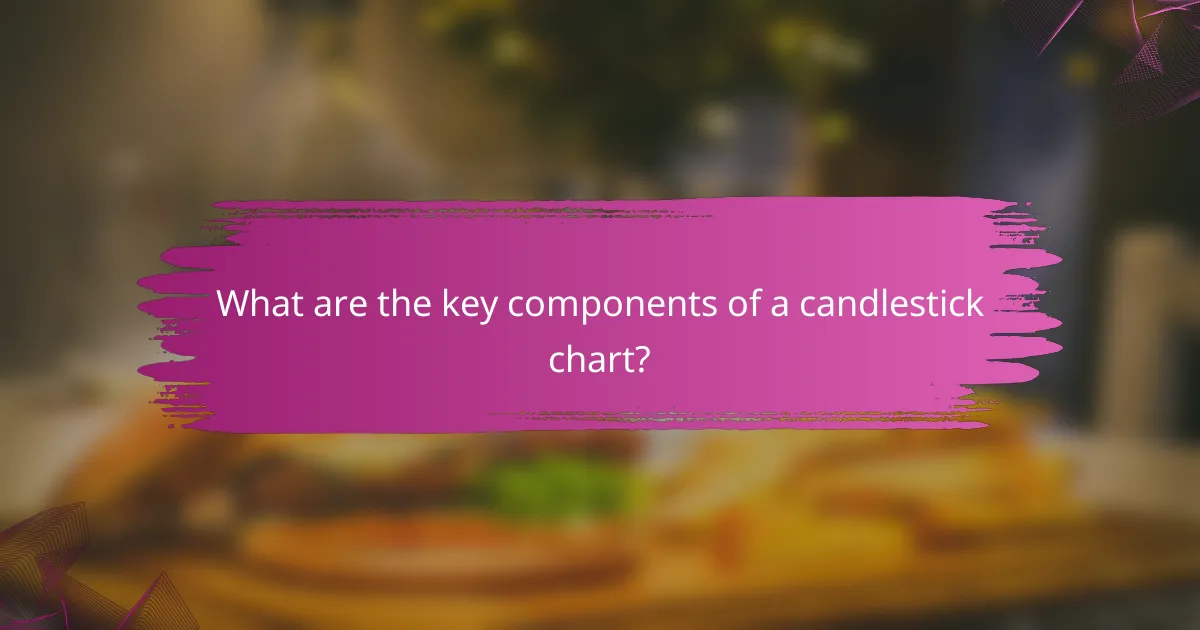
What are the key components of a candlestick chart?
A candlestick chart visually represents price movements in financial markets, highlighting four essential price points: open, high, low, and close. Understanding these components is crucial for analyzing market trends and making informed trading decisions.
Open, high, low, close prices
The open price is the first recorded price of a specific time period, while the close price is the last recorded price. The high price indicates the maximum price reached during that period, and the low price shows the minimum. Together, these four prices form the body and wicks of the candlestick, providing insight into market sentiment.
For example, if a candlestick has a long body with a close price significantly higher than the open price, it suggests strong buying pressure. Conversely, a candlestick with a long wick above the body may indicate a rejection of higher prices, signaling potential selling pressure.
Candlestick patterns
Candlestick patterns are formations created by one or more candlesticks that indicate potential market reversals or continuations. Common patterns include the bullish engulfing, bearish engulfing, and doji, each providing clues about future price movements. Recognizing these patterns can enhance trading strategies.
For instance, a bullish engulfing pattern occurs when a small bearish candlestick is followed by a larger bullish one, suggesting a potential upward trend. Traders often use these patterns in conjunction with other indicators to confirm their analysis.
Timeframes and intervals
Candlestick charts can be created for various timeframes, such as one minute, five minutes, daily, or weekly. The choice of timeframe affects the granularity of the data and the trading strategy employed. Shorter timeframes may be suitable for day trading, while longer timeframes are often used for swing trading or long-term investments.
When selecting a timeframe, consider your trading style and objectives. For example, day traders may focus on one-minute or five-minute charts to capture quick price movements, while long-term investors might analyze daily or weekly charts for broader trends.
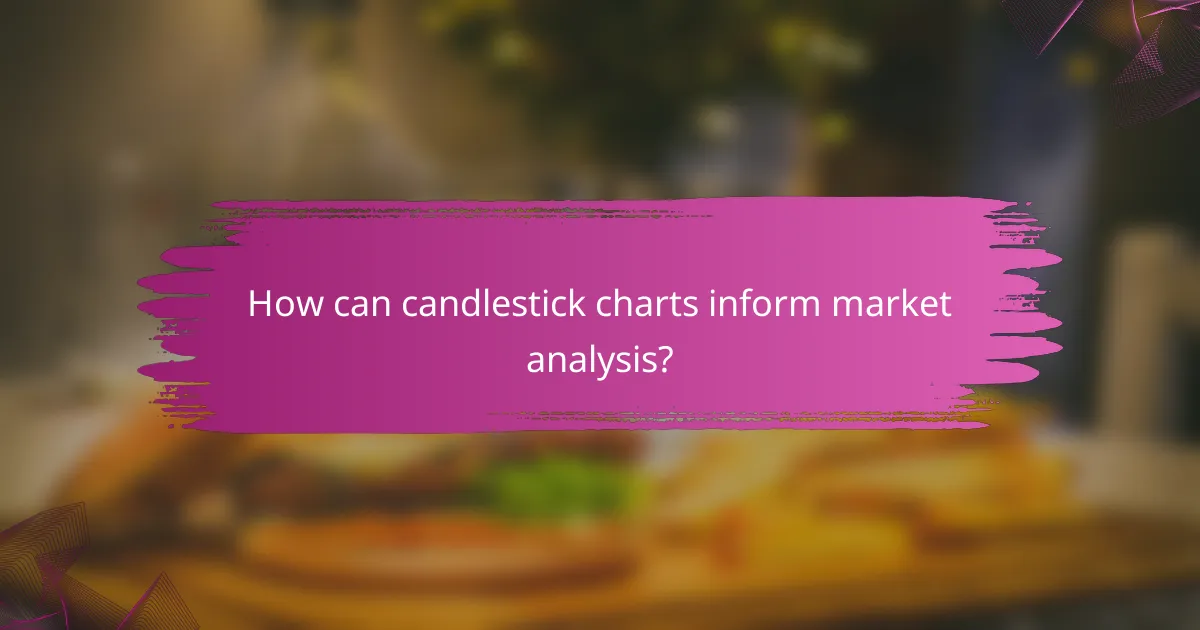
How can candlestick charts inform market analysis?
Candlestick charts are essential tools for market analysis as they visually represent price movements over time, revealing trends and potential future price actions. By interpreting the patterns formed by candlesticks, traders can make informed decisions based on market behavior and sentiment.
Predict future price movements
Candlestick patterns can signal potential future price movements by indicating bullish or bearish trends. For instance, a series of green candlesticks may suggest upward momentum, while red candlesticks could indicate a downward trend. Traders often look for specific formations, such as doji or engulfing patterns, to anticipate reversals or continuations in price action.
To effectively use candlestick charts for predicting price movements, it’s crucial to consider the context of the patterns within the broader market trend. Combining candlestick analysis with other technical indicators, such as moving averages or volume, can enhance predictive accuracy.
Identify market sentiment
Candlestick charts provide insights into market sentiment by illustrating the balance between buyers and sellers. A long-bodied candlestick indicates strong buying or selling pressure, while a short-bodied candlestick suggests indecision among traders. Patterns such as hammers or shooting stars can reveal shifts in sentiment that may precede price changes.
Traders should pay attention to the color and size of the candlesticks to gauge market sentiment effectively. For example, a series of large green candlesticks may indicate bullish sentiment, while consecutive red candlesticks could reflect bearish sentiment. Understanding these signals can help traders align their strategies with prevailing market moods.
Support and resistance levels
Candlestick charts can help identify key support and resistance levels, which are critical for making trading decisions. Support levels are price points where buying interest is strong enough to overcome selling pressure, while resistance levels are where selling interest prevails. Recognizing these levels can guide entry and exit points for trades.
Traders often look for candlestick patterns that form around these levels. For example, a bullish reversal pattern at a support level may signal a good buying opportunity, while a bearish pattern at a resistance level could indicate a potential sell. Monitoring how candlesticks behave at these critical levels can enhance trading strategies and risk management.
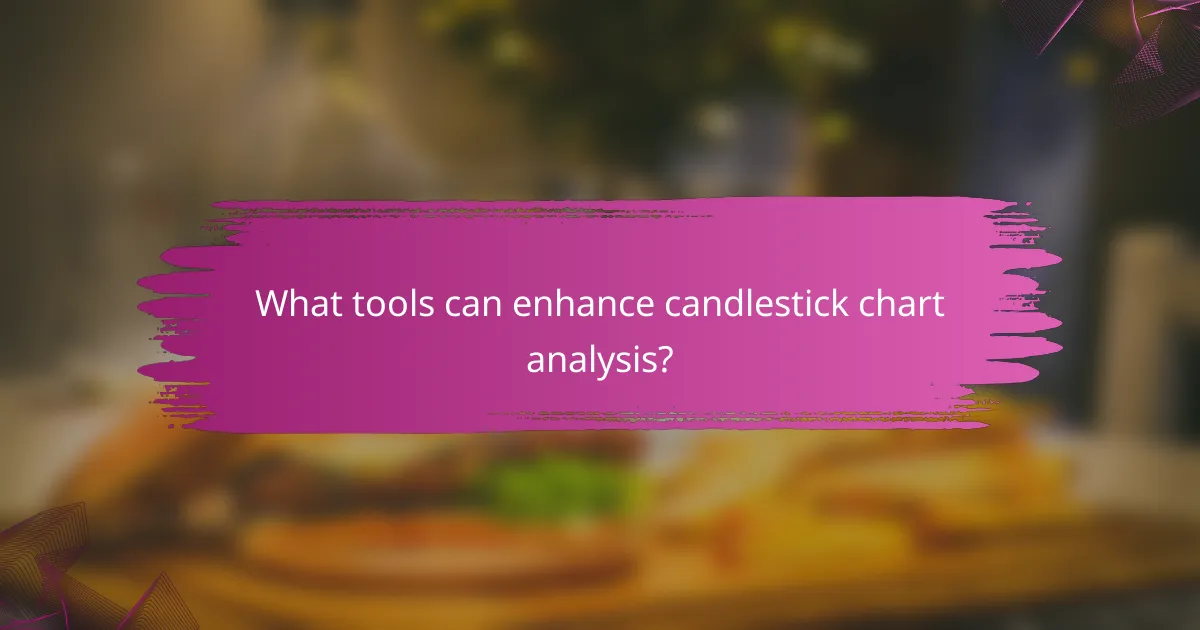
What tools can enhance candlestick chart analysis?
Several tools can significantly improve candlestick chart analysis by providing advanced features and comprehensive data. Utilizing platforms like TradingView, MetaTrader 4, and StockCharts.com can enhance your ability to interpret price movements and market trends effectively.
TradingView platform
TradingView is a popular web-based platform that offers extensive charting tools, including candlestick charts. Users can access a wide range of technical indicators, drawing tools, and customizable layouts to analyze market trends in real-time.
One key feature of TradingView is its social networking aspect, allowing traders to share insights and strategies. This can be particularly beneficial for beginners looking to learn from experienced traders. Additionally, the platform supports multiple asset classes, including stocks, forex, and cryptocurrencies.
MetaTrader 4 software
MetaTrader 4 (MT4) is a widely-used trading platform that provides robust tools for candlestick chart analysis. It offers advanced charting capabilities, automated trading options, and a variety of technical indicators to assist traders in making informed decisions.
MT4 is especially favored by forex traders due to its ability to execute trades quickly and efficiently. Users can customize their charts with different time frames and indicators, allowing for detailed market analysis. However, it is essential to familiarize yourself with its interface to maximize its potential.
StockCharts.com resources
StockCharts.com is an online resource that specializes in charting tools and market analysis. It provides a variety of chart types, including candlestick charts, along with educational resources to help traders understand market dynamics.
The platform features a user-friendly interface and offers various charting options, including overlays and annotations. Additionally, StockCharts.com provides access to market commentary and analysis, which can enhance your understanding of price movements and trends. For effective use, consider leveraging their educational materials to deepen your trading knowledge.
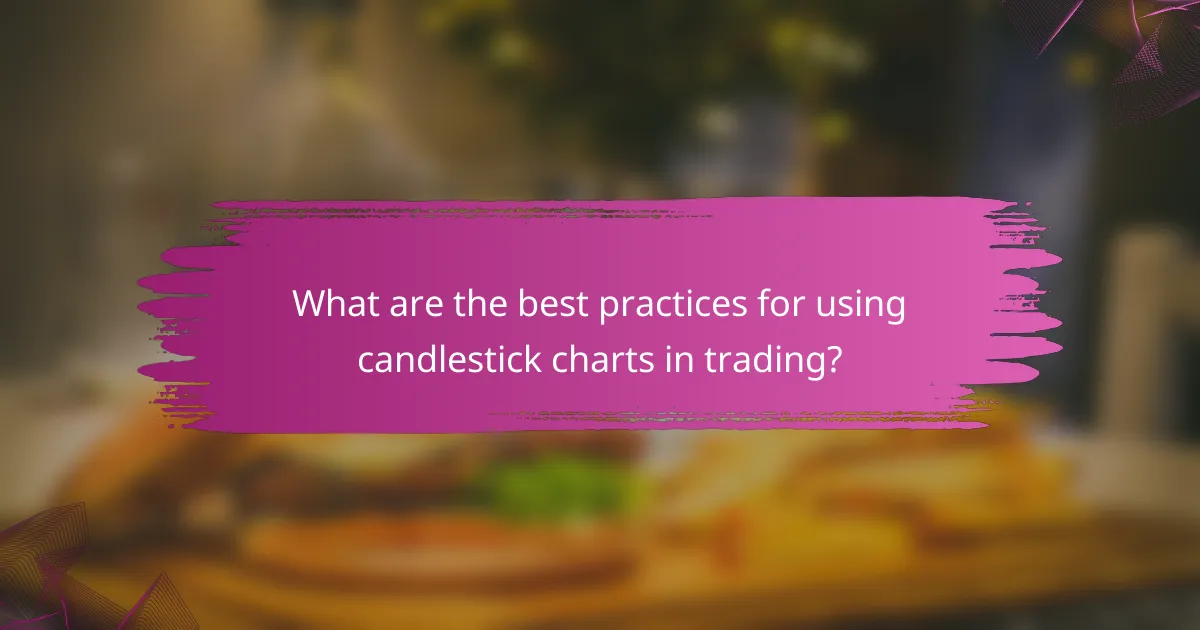
What are the best practices for using candlestick charts in trading?
To effectively use candlestick charts in trading, it’s essential to combine them with other analytical tools and strategies. This approach enhances market analysis, helps identify trends, and improves decision-making.
Combine with technical indicators
Integrating candlestick charts with technical indicators like moving averages or Relative Strength Index (RSI) can provide deeper insights into price movements. For instance, a bullish candlestick pattern confirmed by an upward-moving average can signal a strong buying opportunity.
Common indicators to consider include Bollinger Bands, MACD, and Fibonacci retracement levels. These tools can help traders validate trends indicated by candlestick formations, enhancing the reliability of their trading signals.
Set stop-loss orders
Setting stop-loss orders is crucial when trading based on candlestick patterns. A stop-loss order helps limit potential losses by automatically selling a security when it reaches a predetermined price. For example, if a trader identifies a bullish reversal candlestick, they might set a stop-loss just below the low of that candle to protect against unexpected downturns.
It’s advisable to determine stop-loss levels based on recent price action and volatility, ensuring they are neither too tight nor too loose. This balance helps maintain a favorable risk-reward ratio in trades.
Practice risk management
Effective risk management is vital when utilizing candlestick charts for trading. Traders should only risk a small percentage of their total capital on any single trade, typically around 1-2%. This approach helps preserve capital and allows for continued trading even after a series of losses.
Additionally, diversifying trades across different assets can mitigate risks associated with market volatility. Regularly reviewing and adjusting trading strategies based on performance can also enhance overall risk management efforts.
